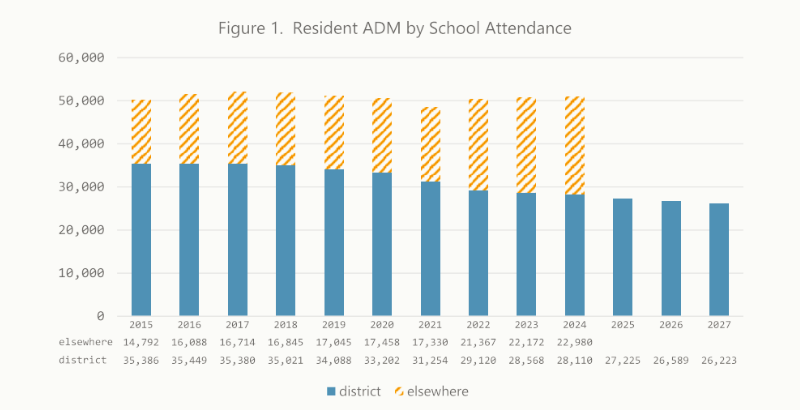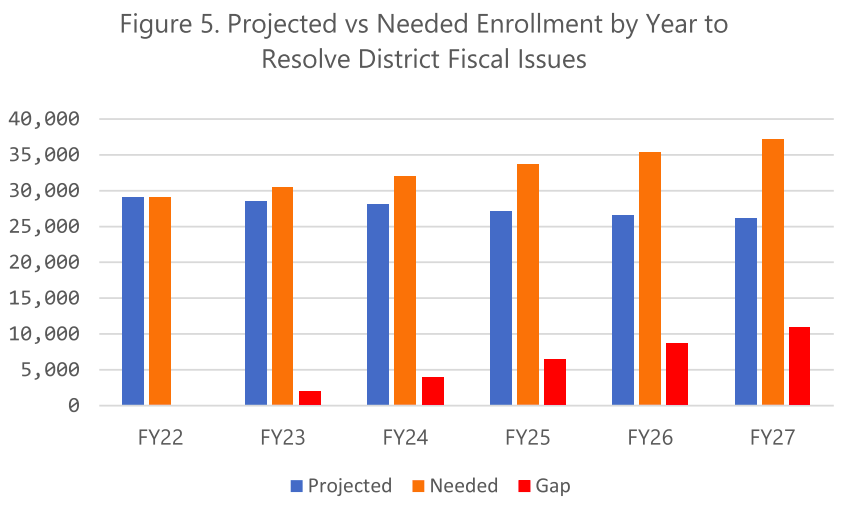Downsize Schools? Keep Them Open & Hope Students Come Back? With Enrollment Down, Minneapolis & St. Paul Split on How to Spend COVID Relief Funds

Get stories like this delivered straight to your inbox. Sign up for The 74 Newsletter
This year, count day — the time when schools take their snapshot of student enrollment — was especially painful in the Twin Cities. Both the Minneapolis and St. Paul districts have been losing students for years, but the decline during the pandemic has been steep indeed.
State officials are still tabulating this year’s count. But preliminary numbers suggest that since the start of the 2019-20 academic year, Minneapolis Public Schools has lost more than 12 percent of its students, while St. Paul has lost almost 10 percent.
Like most states, Minnesota funds schools primarily according to enrollment. A loss of even 3 percent of a district’s student body — the nationwide average last year — can be destabilizing financially. Double-digit losses? There’s no playbook for that.
Both districts have yawning racial and socioeconomic student achievement gaps. In Minneapolis, 74 percent of white students passed last year’s state reading test, compared with 24 percent of children of color and Indigenous students. In St. Paul, 67 percent of white students read at grade level, versus 23 percent of students of color. Similar disparities are seen in math.
Each is also slated to receive more than a quarter-billion dollars in Elementary and Secondary School Emergency Relief Fund aid to help their school systems and students recover from the pandemic. But here, the two cities’ tales diverge.
St. Paul is proposing to close five schools and consolidate 10 more over the next two years, to reflect the current, reduced student head count. Minneapolis plans to use nearly half of its stimulus funds to plug an ongoing budget gap in hopes enrollment will rebound. It is an approach that experts warn will likely create a fiscal cliff that the district will have to deal with when stimulus funds run out.
St. Paul’s reconfiguration plan does not specifically target chronically underperforming schools, but rather buildings the district says don’t enroll enough students to offer all the academics and enrichment classes called for under state standards. The goal is for every school to have at least 350 students, which district leaders say would allow for instruction in music, art and science, as well as support staff such as nurses, counselors and librarians. It’s a controversial plan, slated to be taken up by the school board Dec. 1. But because the vote is being held before four newly elected members are sworn in, it may provide some political insulation for officials willing to say yes.
By contrast, Minneapolis is succumbing to the temptation to spend stimulus funds — more than $108 million — on existing budget deficits. The Council of the Great City Schools, for one, has cautioned its member districts about using the money to hire staff they won’t be able to continue to pay or ink contracts that lead to more inequitable teacher employment. Districts should recall, the group says, that when federal aid from the Great Recession ran out in 2011, tens of thousands of educators were laid off —a disproportionate share of them teachers of color.
“There is a broad appetite across districts to not make too many big cuts right now,” says Marguerite Roza, director of Georgetown University’s Edunomics Lab. “The thinking is, ‘We’re in this chaotic moment, we should protect what we have.’ Of course, if you do that, it’s hard to invest in getting students back on track.” To be most effective, she says, the stimulus dollars need to be targeted as closely as possible to the needs of specific groups of students. Keeping underenrolled schools open and teachers employed does not necessarily mean a district will have the right staff to meet students’ needs.
‘Making some progress right now … is the better play’
Arriving in two allotments to be spent before fall 2024, the Elementary and Secondary School Emergency Relief funding will pump more than half a billion dollars into the Twin Cities’ core school systems. St. Paul Public Schools is slated to receive $299 million, while Minneapolis is in line for $234 million.
Both districts — still reeling from the racial upheaval that followed the murder of a Black man, George Floyd, by a white police officer — have made addressing historic inequities centerpieces of their strategic plans. Both say making sure long-neglected schools get their share of resources is a priority.
Both have also seen dramatic enrollment declines since the 1990s, when the student population totaled 91,000, distributed virtually equally between St. Paul and Minneapolis. Birth rates have declined, and families have increasingly chosen charter schools or taken advantage of open enrollment to send their children to suburban districts. In Minneapolis, the exodus has been most pronounced among Black students. In St. Paul, Southeast Asian students have left in large numbers. Both districts now serve slightly less than two-thirds of the school-aged children who live within their city limits.
Between its larger slice of American Rescue Plan dollars and its decision to deal separately with the challenges posed by decades of falling enrollment, St. Paul has far more money — some $297 million — to spend helping students recover from the trauma and losses of the pandemic.
St. Paul, Roza says, stands out nationally for separating its pandemic recovery efforts from its plan to deal with long-term demographic changes: “Making some progress right now while we’re in chaos — and COVID is chaos — and people are understanding of it is the better play.”
The district’s stimulus spending plan includes $90 million for academics, including $24.5 million to be sent directly to schools to be spent on their most pressing needs, $23 million to place additional teachers in schools to support reading and math efforts, and funds for more instructional time.
Some $11.5 million will support students with specialized needs, such as Indigenous pupils and children with disabilities, and almost $10 million will support a racial equity plan that includes recruiting and retaining diverse teachers. As that proposal was being created, the administrator responsible for each initiative had to specify what would happen when the federal dollars ran out.
Still, efforts to “right-size” the schools have met with stiff political opposition.
Some of the buildings that would be reconfigured under St. Paul’s consolidation plan had been slated for closure or reorganization in 2016. A teacher union-led campaign to organize parents around several flashpoints that year resulted in the election of a school board that fired the superintendent and scrapped the effort.
One of the programs targeted for closure in 2017, Galtier Community School, had 156 students at the time, according to state data. Last year, it enrolled 157, despite district hopes that a renovation would make it more attractive. Now, district leaders want to merge it with nearby Hamline Elementary, which last year enrolled 236 students. Slated for closure are four other elementary schools, Highwood Hills, John A. Johnson Achievement Plus, Jackson and Wellstone, as well as LEAP, a program for high school students who are new to the country that went from 341 students in 2013 to 133 today, according to state enrollment data.
Other changes are designed to respond to families’ preferences, such as replacing a Montessori middle school with a Hmong dual-language immersion, a kind of program popular with many Southeast Asian families who have removed their children from district schools over the last decade.
Confronted with its own underenrolled schools, Minneapolis has repeatedly drawn down reserves and asked voters to approve referenda to deal with budget deficits that by 2018 had mushroomed to $33 million. The district’s chief financial officer has warned that even if enrollment begins to rebound, structural changes are needed.
Several years ago, Minneapolis leaders started talking to families, about 80 percent of them of color, about why they pulled their children out of district schools. The top three answers were a lack of academic rigor, safety concerns and lack of a welcoming feeling, according to Eric Moore, senior accountability, research and equity officer.
Shortly before the pandemic began, Minneapolis launched a redesign that is moving magnet programs, language immersion schools and other popular options into parts of the city that are home to predominantly people of color. These new school attendance boundaries are also geared toward shifting students to the smallest schools and cutting transportation expenses.
District leaders say they expected the shift to be a factor in several more years of enrollment drops before beginning to draw families back around the 2025-26 school year. Though this year’s decline was bigger than anticipated by more than 1,600 students, the plan has reduced the number of schools that are hypersegregated from 21 to 12 and the number of underenrolled schools — which Minneapolis defines as having 250 students or fewer — from five to three.
“It’s a social justice plan, aimed at deconstructing our system of white supremacy that has contributed to years and years of underachievement of students of color, special education students and students in our [English learner] programs,” says Moore. “It’s reinvesting in what our families are saying they want.”
‘This is what it looks like when it gets put off for a long time.’
Because of different ways of calculating enrollment, state and district data differ on the exact size of the student body in any given year. The state has yet to post its 2021-22 tallies, but district leaders say this year Minneapolis has 29,120 students, down from 31,254 last year, 33,202 students for the 2019-20 year and 34,088 in 2018-19. Reach back two more years to 2015-16, and enrollment has dropped 18 percent.

Minneapolis Public Schools
In addition to the unknowns of the pandemic, Moore says, Minneapolis’ larger-than-normal enrollment decline may reflect the racial unrest that has swept the city, either because of white flight or other displacement.
Before the federal stimulus funds were announced, Minneapolis officials had predicted the district would be insolvent by fiscal year 2024. Using recovery funds to make up shortfalls will push that out until 2027, though the district would need “constant enrollment growth” and substantially reduced expenses to avoid completely depleting its funds, according to a recent presentation to the school board’s finance committee. Current enrollment projections show that by that year, the district will need 220 fewer licensed teachers.
Officials say they do not yet have a budget for the stimulus funds that will support “continuity of services, staffing and programs” beyond the $108 million. Of the remaining $126 million, Minneapolis is budgeting $41.3 million for “impacts to learning.”
At the board meeting, Superintendent Ed Graff defended the decision. “Enrollment has declined over the years, and the number of schools that we have does not align with the number of students we have,” he said. “While that is an accurate observation, it’s also an observation that we had never spent the level of investment or the adjustments of our resource allocations in an equitable manner.”
Roza is skeptical. Even if Minneapolis succeeds in drawing back some families, she says, it will have spent funds that could be used to retrain educators and otherwise ensure that any school that grows is appropriately staffed for its students. And if the district has bet wrong, and ends up with a budget in the red, it could land in receivership.
“What usually happens is the state steps in and says, ‘You’re going to become insolvent’ — and then there’s going to be really large pain,” she says. “This is what it looks like when it gets put off for a long time.”
Get stories like these delivered straight to your inbox. Sign up for The 74 Newsletter

;)
